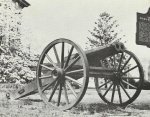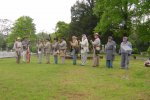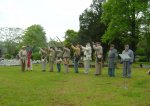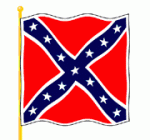Day - 15 Confederate Heritage Month Minute
Robert E. Lee, a man whose military tactics have been studied world wide, was an American soldier, educator, Christian gentlemen, husband and father.
General Robert E. Lee said, "All the South has ever desired was that the Union, as established by our forefathers, should be preserved, and that the government, as originally organized, should be administered in purity and truth."
Let America not forget that General Robert E. Lee was born in Stratford, Westmoreland County, Virginia, on January 19, 1807. The winter was cold and fire places were little help for Lee's Mother, Ann Hill (Carter) Lee.
Ann Lee named her son "Robert Edward" after her two brothers. Lee was educated in the schools of Alexandria, Virginia. In 1825, he received an appointment to the United States Military Academy in New York. He graduated in 1829, second in his class and without a single demerit, a record that stands today.
Robert E. Lee wed Mary Anna Randolph Custis in June 1831. Robert and Mary had grown up together. Mary was the daughter of George Washington Parke Custis, the grandson of Martha Washington and adopted son of George Washington.
In 1852, Lee was appointed Superintendent of West Point.
President-to-be Abraham Lincoln offered command of the Union Army to Lee in 1861, but he refused. In A letter to his sister on April 20, 1861, Robert E. Lee said, "With all my devotion to the Union and the feeling of loyalty and duty as an American citizen, I have not been able to make up my mind to raise my hand against my relatives, my children, my home. I therefore have resigned my commission in the army and save in defense of my native state, with the sincere hope that my poor services may never be needed.
After four terrible years of death and destruction, General Robert E. Lee met General Ulysses S. Grant at Appomattox Courthouse in Virginia on April 9, 1865, that ended their battles.
In the fall of 1865, Lee was offered and accepted the president of troubled Washington College in Lexington, Virginia. He died there of a heart attack on October 12, 1870.
Robert E. Lee, a man whose military tactics have been studied world wide, was an American soldier, educator, Christian gentlemen, husband and father.
General Robert E. Lee said, "All the South has ever desired was that the Union, as established by our forefathers, should be preserved, and that the government, as originally organized, should be administered in purity and truth."
Let America not forget that General Robert E. Lee was born in Stratford, Westmoreland County, Virginia, on January 19, 1807. The winter was cold and fire places were little help for Lee's Mother, Ann Hill (Carter) Lee.
Ann Lee named her son "Robert Edward" after her two brothers. Lee was educated in the schools of Alexandria, Virginia. In 1825, he received an appointment to the United States Military Academy in New York. He graduated in 1829, second in his class and without a single demerit, a record that stands today.
Robert E. Lee wed Mary Anna Randolph Custis in June 1831. Robert and Mary had grown up together. Mary was the daughter of George Washington Parke Custis, the grandson of Martha Washington and adopted son of George Washington.
In 1852, Lee was appointed Superintendent of West Point.
President-to-be Abraham Lincoln offered command of the Union Army to Lee in 1861, but he refused. In A letter to his sister on April 20, 1861, Robert E. Lee said, "With all my devotion to the Union and the feeling of loyalty and duty as an American citizen, I have not been able to make up my mind to raise my hand against my relatives, my children, my home. I therefore have resigned my commission in the army and save in defense of my native state, with the sincere hope that my poor services may never be needed.
After four terrible years of death and destruction, General Robert E. Lee met General Ulysses S. Grant at Appomattox Courthouse in Virginia on April 9, 1865, that ended their battles.
In the fall of 1865, Lee was offered and accepted the president of troubled Washington College in Lexington, Virginia. He died there of a heart attack on October 12, 1870.







